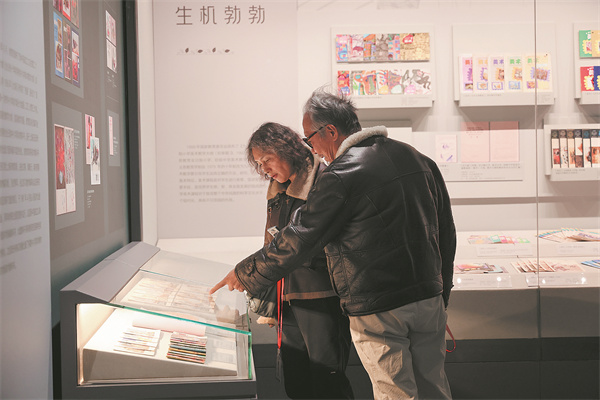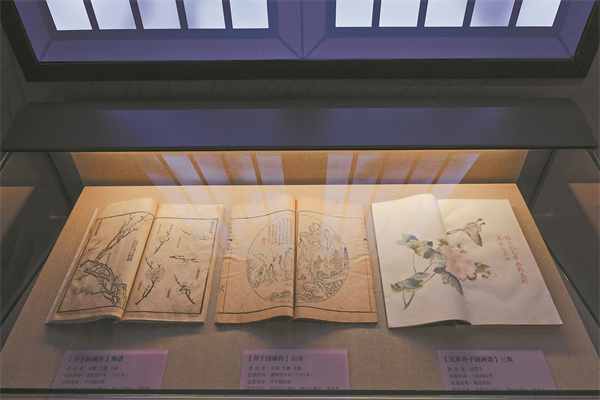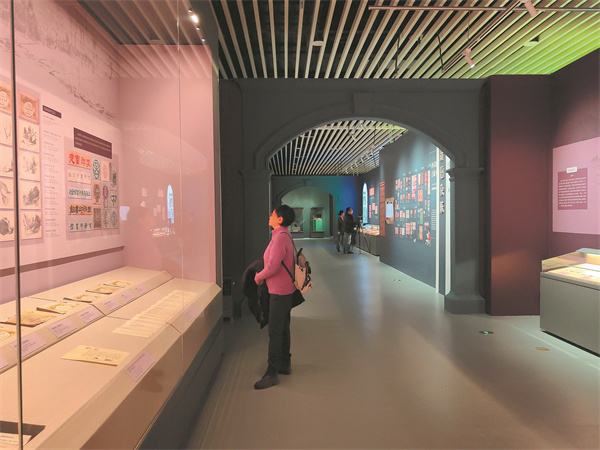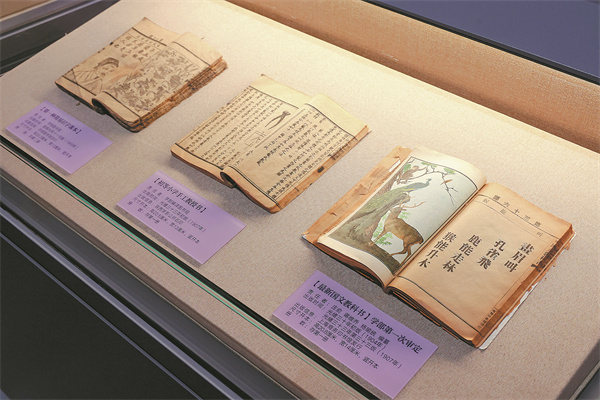
Visitors examine the exhibits on Jan 8.[Photo provided to China Daily]
In his article penned in 1934, painter Feng Zikai (1898-1975) recalled childhood enlightenment as he learned about painting. When he studied Chinese poetry and the Three-Character Classic, a 13th-century text for children on Confucian philosophy, he found himself, instead of being captured by the text, seized by the illustrations. These images intrigued him so much that he began coloring them using pigment from his family's dyehouse.
"The children new to school enjoy coloring illustrations in textbooks," says Li Hongbo, an art professor at Jilin Normal University. "They may have limited understanding of colors but they often take pride in their 'creations' and find endless pleasure from such activities.
"This is a prevalent phenomenon and can even serve as a gateway for children to learn about painting. It also signifies that textbooks from other subjects can contribute to the fundamental fine arts education."
Feng's story is shown in the ongoing Mirror to the Future: Chinese Basic Art Education Literature Exhibition, which highlights the development of the country's fundamental fine arts education since 1904, at The First Historical Archives of China in Beijing.
Organized by the archives and Beijing Normal University, the exhibition traces the 120-year history of the development of basic fine arts education in China, from early exploration and middle-stage tortuous development to it thriving in the new era, through 1,359 items, including files, textbooks and teaching aids. It runs until July.
"This exhibition showcases the rich value of fine arts education in enhancing the ability to appreciate beauty, cultivate sentiments, nurture the soul, and stimulate innovative vitality. … It also enables the rich archival resources containing historical, cultural and aesthetic value to integrate into the field of education, giving full play to their roles of preserving history and educating people," says Wang Hongyun, director of the archives.

Regional fine arts textbooks are displayed at an exhibition on China's basic art education at The First Historical Archives of China in Beijing.[Photo provided to China Daily]
The exhibition starts from Jieziyuan Huapu, or The Mustard Seed Garden Manual of Painting, a Qing Dynasty (1644-1911) standard manual on Chinese ink painting. Three copies of it are in the exhibition, among which two were published in 1701 and one is from the early 20th century, as a gift from Chinese writer Lu Xun (1881-1936) to his wife Xu Guangping.
The manual has examples of tree, flower, insect, rock, figures and architectural patterns besides Chinese painting techniques and classic artworks by famous painters.
"Since its publication, this textbook has garnered immense popularity and acclaim as a cherished resource in folk fine arts. Numerous Chinese painters expressed how profoundly they had been influenced by its content. Consequently, it stands as a crucial testament to the evolution of fine arts education in China," says Li, also curator of the exhibition.

Copies of Jieziyuan Huapu, a Qing Dynasty (1644-1911) standard manual on Chinese ink painting.[Photo provided to China Daily]
Historical value
The formal education of fundamental fine arts is believed to have started from 1904, when Emperor Guangxu of the Qing Dynasty issued a document on the new educational system of China, which introduced fine arts to curricula.
There are many related archives on display showing the huge waves of reforms in China's education at that time. Wang says their organization preserves a number of archives related to this part of history, which are unique and of high historical value.
In earlier times, keju, or imperial exams, prevailed as the primary method through which individuals could ascend to governmental positions. Within this framework, Chinese students mostly learned Confucian classics in home schools under the guidance of private tutors.
But at the end of the Qing Dynasty, people gradually realized the system lagged behind with the development of the times. Following the 1904 document, keju was abolished in 1905 to promote the establishment of various new schools, which borrowed experience from foreign countries and imparted knowledge of more subjects like math, science and fine arts.
The exhibition shows a telegraph from Qing Dynasty official Zhang Zhidong to his colleague Duanfang in 1902, which described Zhang's advice of curricula setting, and another one from official Liang Dingfen to Zhang in 1903 about setting up kindergartens, primary and middle schools in the capital, present-day Beijing.
"They all demonstrate during the germinating period of basic fine arts education that officials in different places promoted rudimentary changes in the educational system, which finally led to rich and diversified subjects in new schools so that fine arts could thrive," says Li.

The Mirror to the Future: Chinese Basic Art Education Literature Exhibition at The First Historical Archives of China in Beijing features files, textbooks and teaching aids that outline 120 years of basic fine arts education development in China.[Photo provided by Wang Ru/China Daily]
A highlight of the exhibits is a memorial to the throne from official Li Zhuohua applying for the simultaneous running of both the new education system and keju in 1907.
In the past, keju was not only an education system but also a way of selecting government officials, as successful candidates in the exams would obtain government positions. But under the new system, schools were only places imparting knowledge, severing the direct link between learning and official appointments. As a result, many people refused to enter new schools and wanted to cling to the old system. Li Zhuohua proposed this compromise approach to navigate the situation, says Li Hongbo.
Although his advice was not adopted, the file still records people's exploration in the reform of China's educational system during that time, he adds.
When fine arts subjects were added to classes, suitable textbooks were needed as important tools of education. The exhibition shows the early folk fine arts textbooks, a memorial to the throne by official Wang Buying to compile official textbooks in 1906, and the finally published official textbooks by the imperial educational ministry of the Qing Dynasty in 1909.
"At that time, various folk textbooks — some from foreign countries — were used nationwide. Wang Buying believed some of them were not suitable for China's education, and hoped to compile the official textbooks, leading to the birth of the earliest ones," says Li Hongbo.

Textbooks with illustrations help students learn fine arts.[Photo provided to China Daily]
Diverse styles
Since 1912, following the downfall of the Qing Dynasty, fine arts education continued to evolve with the times, viewed as a period of exploration.
In 1917, educator Cai Yuanpei (1868-1940) proposed to "replace religion with aesthetic education", highlighting the role of fine arts education in cultivating noble characters by nurturing people's emotions, transcending the earlier perception of fine arts education solely as a way of imparting practical skills during the Qing Dynasty.
The colorful covers of fine arts textbooks in the 1930s and 1940s on display reveal the growing impact of foreign culture. This influence has contributed to diverse painting styles, resulting in the development of textbooks covering a broad spectrum of arts, including pencil drawings, brush paintings, crayon drawings, pen drawings and watercolor paintings, says Li Hongbo.
Even during the turbulent times of the War of Resistance Against Japanese Aggression (1931-45) and the War of Liberation (1946-49), basic fine arts education was not abandoned.
Also in the exhibition is a fine arts textbook used from 1938 to 1945 by schools in Huixian county, Henan province, run by the Eighth Route Army led by the Communist Party of China.
"It's a rare exhibit, telling us even in difficult times, Chinese people did not give up fine arts education. Teachers and art professionals drew to promote the revolution, and children painted their aspirations for a better life, laying a solid foundation for the development of fine arts in New China," Li Hongbo says.
Since the founding of New China in 1949, fine arts education has developed rapidly. The syllabuses and curriculum standards of the subject have improved with changes of ideas about the role of fine arts.
In 2022, the latest art curriculum standards for compulsory education were issued with the aim of nurturing hearts and guiding students to perceive, experience and understand art in aesthetic practices. Last year, guided by the standards, the latest fine arts textbooks were published across the country, as shown in the exhibition.
Li Hongbo also highlights the significance of regional textbooks as supplements to their official counterparts. These books feature local characteristics and initially emerged in the 1980s to address the shortcomings of official educational materials.
For example, at that time, some students from southern China had never seen snow and found it hard to draw snowy landscapes. Also, students from northern China did not have the concept of a coconut tree since they had never seen one.
"Regional textbooks often utilize local landscapes and cultural elements as educational tools to showcase the unique cultural resources of a particular region, serving as a complement to the national standard textbooks. Both types of textbooks have run concurrently and have evolved into essential models in our foundational fine arts education," says Li Hongbo.